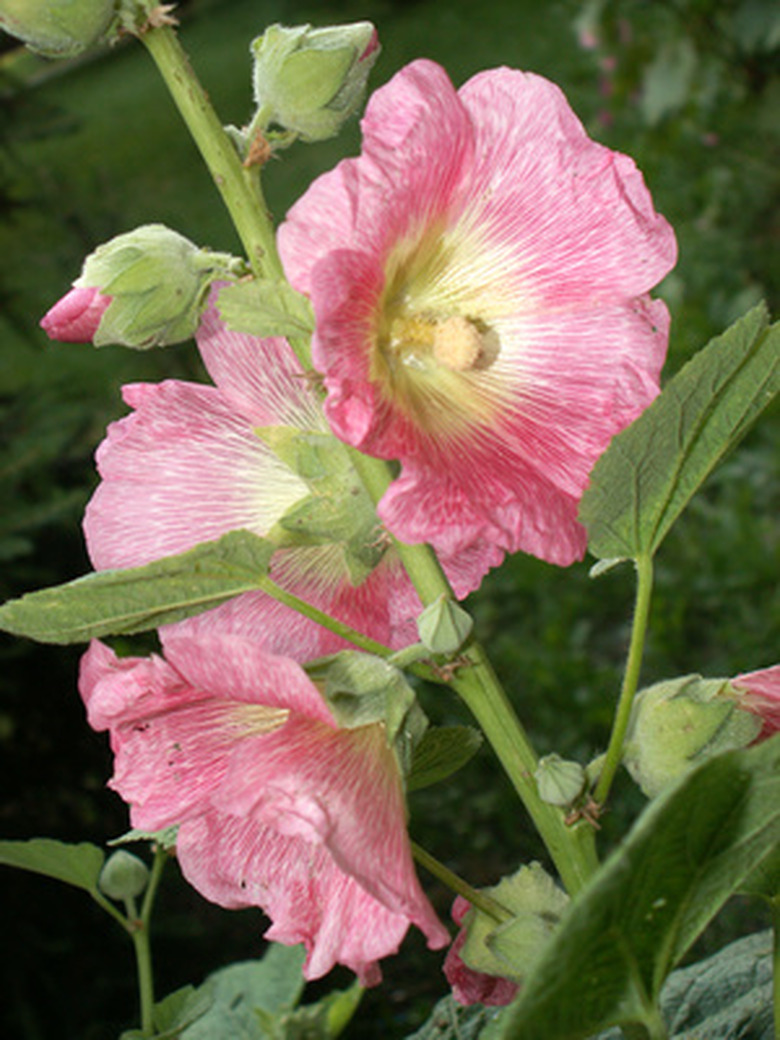Flowers Used For Dye
Natural dyes have been used for thousands of years. Many different herbal materials such as tree bark, plant parts, fruits, berries and even some insects were used in dye production. Although many herbal dyes have been replaced by synthetic varieties, some natural dyes are still used to add color to foods, cosmetics and fabrics. A number of different colors are created with flowers and flower parts.
Hollyhocks
Hollyhock, or Alcea rosea, petals are available in varying shades from nearly white to almost black. The dyes made from these petals range in color from bright green to greenish brown depending upon how the blossoms are prepared. According to Rakhi Shanker and Padma S. Vankar from the Facility for Ecological and Analytical Testing in Kanpur, India, a substance such as alum or other metal salts is used to make the dye stay on the fabric without quickly washing out. This substance is called a mordant. Shanker and Vankar experimented with mordants such as copper sulphate and stannic chloride as well as alum and found that the color varied depending upon which mordant was used.
- Natural dyes have been used for thousands of years.
- Many different herbal materials such as tree bark, plant parts, fruits, berries and even some insects were used in dye production.
Saffron
Saffron, or Crocus sativus, creates a strong yellow dye. According to W.P. Armstrong from Palomar College, saffron's blossoms contain a coloring pigment in their stigmas, which are the long tube-like structures inside the middle of the blossoms. This coloring pigment is called crocin, and it is a distant relative of vitamin A. The stigmas are dried and used for dyeing. The website indicates that approximately 4000 flowers are needed to make a single ounce of dye. Saffron was once used to dye the robes of Irish royalty, according to Armstrong. It is used most often as a food coloring.
- Saffron, or Crocus sativus, creates a strong yellow dye.
- This coloring pigment is called crocin, and it is a distant relative of vitamin A.
- The stigmas are dried and used for dyeing.
Royal Poinciana
Delonix regia is also known as Royal poinciana or Gulmohur. These trees produce striking golden and scarlet flowers during the spring. Dyes created from gulmohur blossoms range in shades from golden yellow to dark brown, depending upon the mordant. According to K. Anitha and S.N. Prasad from the Salim Ali Centre for Ornithology and Natural History in India, dyes that used turmeric powder as a mordant produced golden yellow or dark tan shades on silk depending upon whether the whole flowers or just the petals were used. A 10 percent alum solution produced olive green.
Safflower
Younsook Shin from Chonnam National University in Korea indicates that Korea has a long tradition of using safflower as a natural dye. Safflower petals contain carthamin, which produces red, and safflower yellow B, which produces an orange-yellow color. Healthline adds that safflowers were traditionally used to dye silk yellow or red. The blossoms were also dried, finely ground and mixed with talc to produce rouge. Safflower dye is commonly used to add color to foods.
- Delonix regia is also known as Royal poinciana or Gulmohur.
- Healthline adds that safflowers were traditionally used to dye silk yellow or red.
